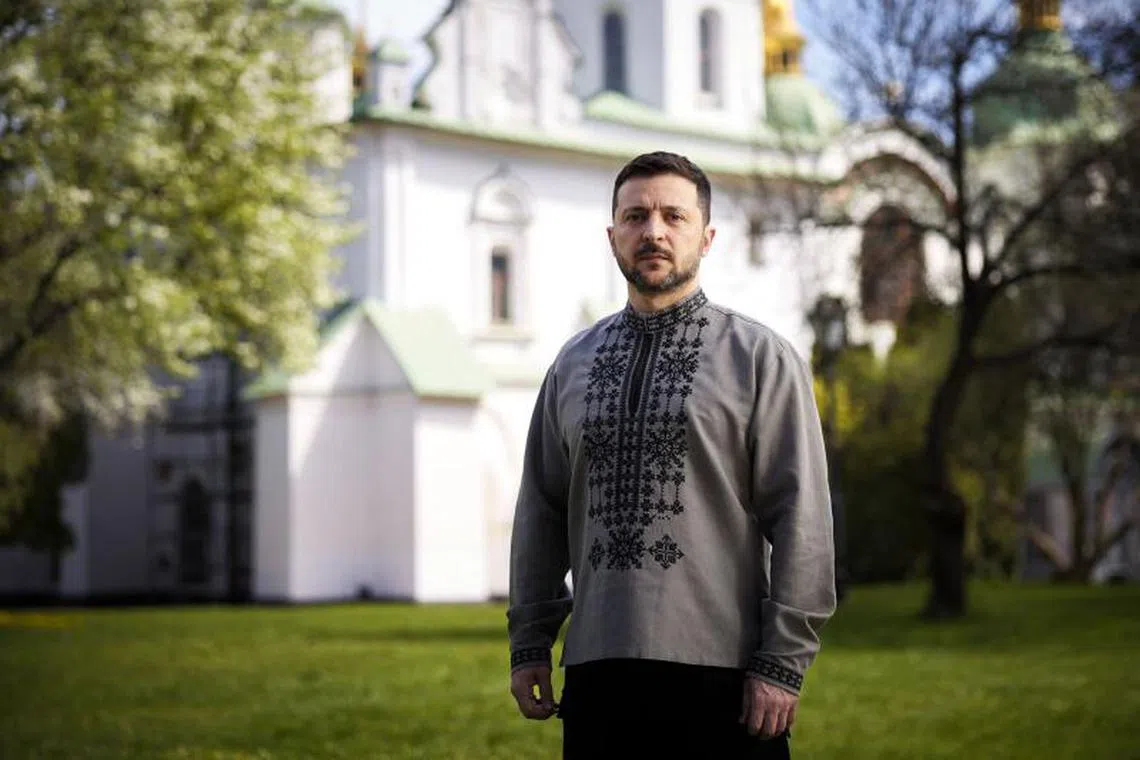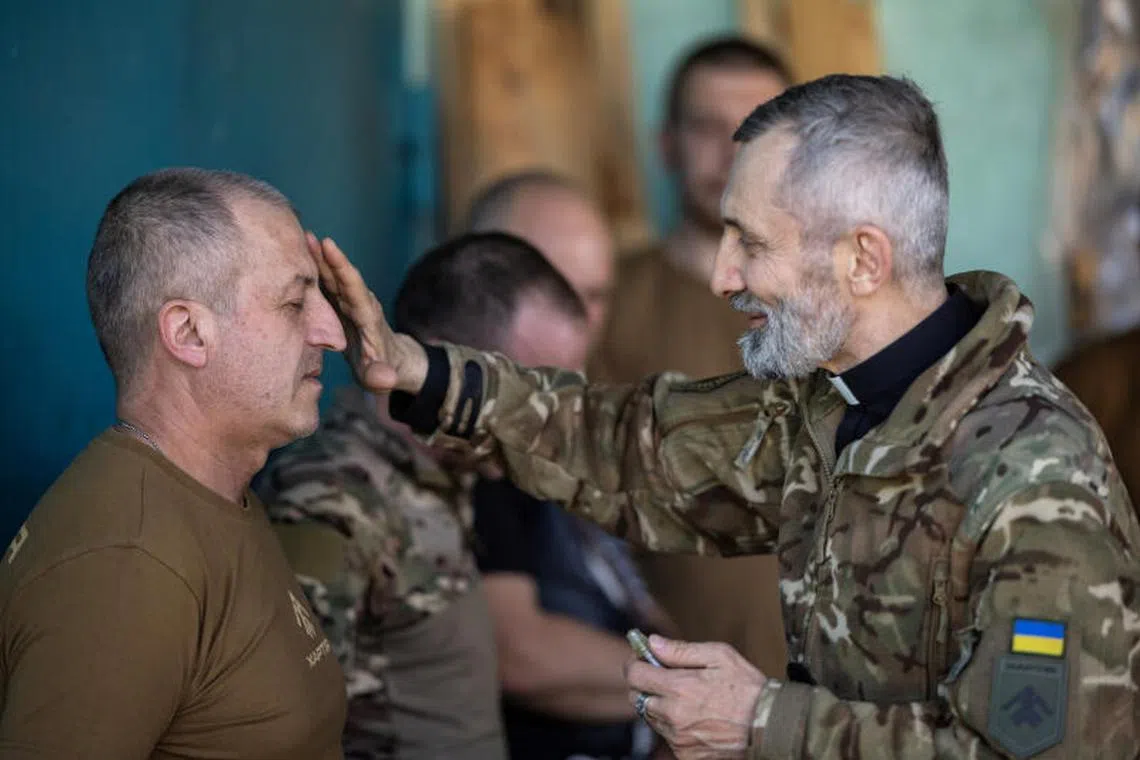Zelensky says Russia broke its own Easter ceasefire vow ‘more than 2,000 times’
Sign up now: Get ST's newsletters delivered to your inbox

A handout picture showing Ukrainian servicemen taking part in Easter service in Zaporizhzhya region on April 20.
PHOTO: AFP
Kim Barker
Follow topic:
KYIV - Mr Serhiy Hnezdilov spent the night of April 19 in a ceasefire that wasn’t. Fighting for Ukraine in the eastern Donetsk region, he said he could hear explosions throughout the night, despite the Kremlin’s promise of a truce for Easter.
Mr Hnezdilov, 24, said Ukrainian soldiers were told to report to their superiors all violations of the ceasefire, which was abruptly declared by President Vladimir Putin of Russia on April 19 afternoon and later agreed to halfheartedly by sceptical Ukrainian officials. In addition, Mr Hnezdilov said, some planned Ukrainian military operations had been put on hold.
“I don’t even know how to assess this so-called ceasefire,” said Mr Hnezdilov, whose 56th Mariupol Brigade is fighting near the town of Chasiv Yar. “To me, it was just words from Putin like, ‘We won’t shoot,’ but they are shooting,” he said in an interview on April 20, adding: “Every so-called ceasefire with the Russians gets violated by the Russians immediately.”
The truce, announced as lasting 30 hours
On April 18, the Trump administration indicated that if it could not make progress
Without US help, Ukraine’s ability to continue fighting is tenuous. As the military aid initially authorised under President Joe Biden slows to a trickle, Ukraine has been able to win more military help from Europe. But it also depends on the United States for essential military intelligence and targeting data, and for the Patriot missiles used in its air defenses.
The truce – announced by Mr Putin less than two hours before it was to start at 6pm local time on April 19 – did mean a quieter night.
But both Ukraine and Russia claimed on April 20 that attacks had continued, with the other side responsible for violating the ceasefire.
Russian troops had violated the ceasefire “more than two thousand times” as of 8pm on April 20 (1am on April 21, Singapore time), President Volodymyr Zelensky of Ukraine said in social media posts. He said there were 1,355 cases of Russian shelling and that Russians had launched 67 assaults against Ukrainian positions across various directions.
Russia’s Defense Ministry said on April 20 that its forces had observed the truce, while accusing Ukraine of violating it with drones and nighttime attacks in the Donetsk region. The ministry provided its own numbers: Ukraine had fired 444 times from guns and mortars and carried out 900 drone strikes.
It was not possible to confirm independently the claims by either side.
Both Kyiv and Moscow said that fighting had continued along the border between Ukraine and the Kursk, Belgorod and Bryansk regions of Russia.
Mr Vlad Krupko, 26, a drone unit commander in eastern Ukraine, said the fighting during the ceasefire was similar to how it had been since Russia launched its full-scale invasion in February 2022. The Russians continued to launch drones and artillery strikes, while his team conducted combat drone flights. “So in reality, there was no ceasefire at all,” he added.
US President Donald Trump has made ending the war in Ukraine one of his foreign-policy goals. But his administration has largely echoed Russian talking points so far, saying that occupied parts of Ukraine should be ceded to Russia and that Kyiv should not be able to join Nato. There is no serious talk in the White House or in Congress of sending more military aid to Ukraine. Mr Trump has made his disdain for Mr Zelensky clear, as well as his affinity for Mr Putin.
Ukraine is largely at the mercy of whatever the Trump administration decides, if it wants any chance of more American help. When Mr Trump briefly paused both military intelligence and military aid in March, after a public blowup with Mr Zelensky
So Mr Zelensky has agreed and agreed, trying to look reasonable compared with Mr Putin. He agreed to a 30-day temporary ceasefire proposed by Mr Trump in March. He agreed to pursue a contentious revenue-sharing minerals deal that could be finalised this week.
By contrast, Mr Putin has not agreed to much of anything concrete during preliminary talks with US officials.
April 18 seemed to be a breaking point. US officials made it clear that they were exasperated with Russia’s unwillingness to accept the 30-day ceasefire proposal.
Secretary of State Marco Rubio said the United States could decide within days to “move on” from trying to end the war. Mr Trump said that “if for some reason one of the two parties makes it very difficult,” the United States could decide that “we’re just going to take a pass.”
Only Vice-President J.D. Vance sounded more upbeat, saying that the United States was optimistic about putting an end to the war – although he did not say how.
Then on April 19 afternoon, Mr Putin ordered his forces to “stop all military activity” against Ukraine for 30 hours.
Mr Zelensky and other Ukrainian officials expressed scepticism about Mr Putin’s intentions, but eventually, probably mindful of Mr Trump’s desire for a ceasefire, Mr Zelensky said Ukrainian troops would do whatever Russian troops did. If they were silent, Ukrainian troops would stop fighting. If Russian troops attacked, so would the Ukrainians.

A handout photo showing Ukraine’s President Volodymyr Zelensky posing at the occasion of Easter celebrations, in Kyiv.
PHOTO: AFP
“Our soldiers are responding everywhere as the enemy deserves,” he said in a social media post April 20 morning.
In another clear signal to Washington, Mr Zelensky reiterated several times over the weekend that Ukraine would like to extend the Easter truce for 30 days. On April 20, Mr Putin did not extend the Easter ceasefire
On April 20, Ukrainian analysts largely dismissed the temporary ceasefire as a public relations stunt. They were much more concerned about what it meant if the US administration pulled out of any role in the peace negotiations.
“This is the big question to us Ukrainians: What do they mean by being out?” asked Mr Volodymyr Dubovyk, the director of the Centre for International Studies at Odesa I.I. Mechnikov National University. “Does it actually mean that they are completely ignoring the conflict from now on, if they are out? Or will intelligence sharing still be coming to Ukraine? Will satellite imagery still be coming to Ukraine?”

Military chaplain conducts Easter service for Ukrainian service members near a front line in Kharkiv region.
PHOTO: REUTERS
The minerals deal, if signed, could give Ukraine some kind of leverage to be able to get more US weapons or at least to continue receiving US military intelligence, analysts said.
Easter is one of the most important holidays of the year in Ukraine. On the Thursday before Easter – called Clean Thursday – Ukrainians typically clean their houses. Life grinds to a halt on Good Friday. Spare time is devoted to elaborately decorating eggs and baking special Easter cakes.
But no one in Ukraine seemed to see Putin’s truce offer as a gift. Video posted online on April 20 showed Russian drones attacking an evacuation vehicle near the city of Kostiantynivka in Donetsk, injuring the occupants.
On April 20 morning, villagers in Kamyanka in the eastern Kharkiv region attended an Easter Benediction next to the charred remnants of a church that was destroyed during the village’s five months of Russian occupation, which killed about 150 civilians and destroyed homes, shops and farms.
Ms Iryna Trotsko, 52, said in an interview that she would never trust the Russians. “They don’t keep their word or any of the promises they make to us,” she said. NYTIMES

